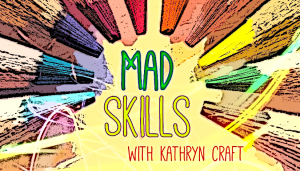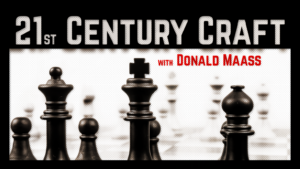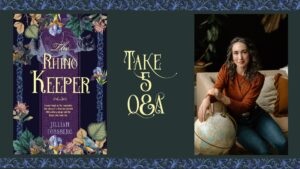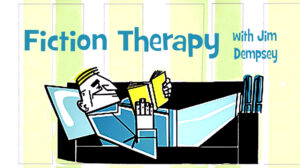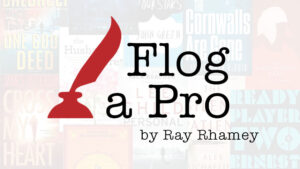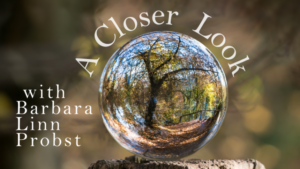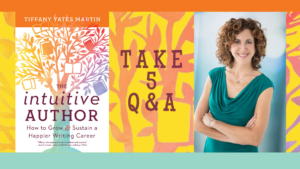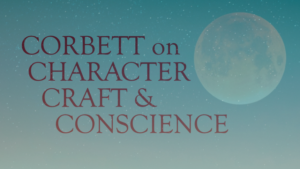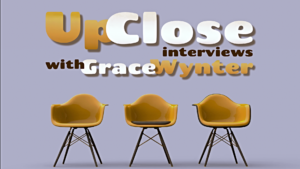CRAFT
photo adapted / Horia Varlan
In the masterful first paragraph of her debut novel, River Sing Me Home, British novelist Eleanor Shearer shows that you don’t need a cascade of words to set multiple levels of story movement in play.
It’s always fun to see what you can glean from an opening while approaching a novel stone cold, so let’s give it a go.
It was the blackest part of the night and Rachel was running. Branches tore at her skin. Birds, screeching, took flight at the pounding of her strides. The ground was muddy and uneven, slick with the residue of recent rains, and she slipped, falling hard against the rough bark of a palm tree. She slid down to the soil, to where ants marched and beetles scurried and unseen worms burrowed through the earth. With ragged breaths she gulped the heavy, humid air into her lungs. She could taste its dampness on her tongue, tinged with the acidic bite of her own fear. What had she done?
Line by line, let’s look at what Shearer accomplishes in only these 106 words. At the end of each explanation I’ll identify in blue the factors contributing to story movement.
This story literally hits the ground running by setting the protagonist in motion—at night. A question is immediately raised: “Why?”
Character movement, anticipatory atmosphere, question raised
This short, declarative sentence leaves no room for doubt—at the moment, Rachel cannot think of her comfort. Nature itself conspires to hold her back. We are entering a story in which stakes are attached. The question evolves: “Why is Rachel doing this dangerous thing?”
Obstacle, interactive setting, stakes, prose support, story question extended
Rachel blasts through obstacles with pounding strides, exposing her desire and proving her agency. Shearer’s verb choices—“screeching” and “pounding”—extend the sense of danger. Commas spotlight the reaction from the birds.
Desire, agency, specific verb usage, an interactive setting, prose support
Whatever is going on with Rachel will have an impact on her world.
Interactive setting, foreshadowing, spreading stakes, anticipation of an off-screen antagonist, fear
Nature continues to pose obstacles, this time causing her to fall. The palm tree, and the humid air to come, place the story in a tropical locale. As she suffers this mishap, the forward pace of the prose is slowed with longer sentences, and multiple commas, as if the reader herself was mired in mud.
Obstacles suggest a gauntlet, interactive setting, conflict, setting orientation, consequences, prose support
Rachel’s flight intersects with a universe in which living beings come and go, appear and hide, and go about their work as […]
Read MoreI’m guessing, given Tuesday’s election, most of us have been living in a world of, shall we say, heightened reality the past few days (if not weeks, or months). So, with no desire to diminish the importance or impact of that reality, allow me to offer a bit of a diversion, one I’ve had planned for some time: here’s an interview with Rachel Howzell Hall, known for her bestselling thrillers, about her turn to romantic fantasy with her latest book.
Rachel has been on a bit of a tear lately: her most recent previous novel, We Lie Here, was both a bestseller and nominated for a Los Angeles Times Book Prize. Before that she had three bestsellers in a row, What Fire Brings, What Never Happened, and These Toxic Things (also nominated for the Anthony Award, the Strand Critics Award, and the Los Angeles Times Book Award), with And Now She’s Gone garnering nominations for the Lefty, Barry, Shamus, and Anthony Awards.
With so much success in the thriller category, why jump ship and climb aboard an entirely different genre? I asked her that question (see below).
Meanwhile, The Last One, which comes out December 3, has garnered significant pre-publication praise:
The Last One can be pre-ordered now at Bookshop.Org, Amazon, B&N, Google Books, Kobo, Apple Books, or at your favorite local bookstore.
How did your agent (and/or editor/publisher) respond when you proposed a book so different from your past work?
Actually, it was my agent Jill Marsal who first reached out with the possibility of collaborating with publisher Liz Pelletier. I was thrilled at the opportunity—Liz is a genius. She was preparing to launch a new imprint from Entangled called Red Tower, filled with high-concept ideas she wanted to bring to life. I was honored to be one of the writers she thought would be a good fit for the project.
I get the feeling that this is a book you’ve been wanting to write for some time—have I got that right? If so, what kept you from getting to it sooner? How long did it take to imagine it, plot it out, and then get it down on the page?
I didn’t realize I wanted to write this book until I actually started. I was pretty intimidated by the idea of tackling not just one, but two new genres. I had never written a romance, and I had never written a fantasy. However, I soon discovered that I still had a lot to say—things I’d expressed before in mystery and crime—but now I had the opportunity to explore them in a world I could entirely create. A world without rules, until I made them.
I was offered the opportunity in July 2022 and began writing. I […]
Read MoreTwo weeks ago, I gathered my courage (it was stuffed in a storage bin under my bed) and volunteered to make calls to Undecideds in Pennsylvania. My even-keeled, deeply-uncomfortable-with-confrontation husband was worried. Rightfully so. I am unevenly-keeled. One of my keels is a sectional sofa. The other, a ping pong ball.
“You might have a hard time,” he said, “not getting into it with people. People can be rude. And sometimes you get into it with people who are rude.”
He was wrong about this. I don’t sometimes “get into it” when people are rude. I almost always and always immediately “get into it” when people are rude.
“There’s a script,” I explained, full of bravado. “And I’m not trying to sway people. I’m only checking to make sure they have a voting plan. Also, these people reside in Pennsylvania, the state that contains the City of Brotherly Love. It’ll be fine.”
I did have a snazzy script to follow. Depending on how the Undecideds responded to my first question, I’d click a button, and instantly be taken to a specific script meant for someone who had responded in that particular way. Like a Choose-Your-Own-Adventure, except that Undecided strangers were my adventure-choosers.
“I’ll stick to the script,” I promised my husband. “I will.”
Alas, nearly 100% of people on the Undecided Brotherly Love list either hung up on me immediately, or, right after I introduced myself, warned that I should, “STOP CALLING!” Or that I, “WASN’T GOING TO CHANGE THEIR MIND!” Or, as one fellow not-lovingly suggested, “GO TO HELL!”
But instead of “getting into it” with these Pennsylvanians, I felt only empathy. These folks have been barraged by politics–TV ads, calls, texts, emails–for months. They weren’t rude. They were weary.
Weary too, I invented a new goal: connect with the weary. NOT to change their minds, but, perhaps to feel less alone in my own weariness.
My selfish, rebellious script went a little something like this:
My name is Sarah, and I don’t know about you, but I cannot WAIT to be on the other side of November 5th. How are you holding up?
Dozens of people still hung up on me. But some did not.
Not-Tanya, for example.
“I am NOT Tanya,” she said, after I asked to please speak to Tanya. “I have never BEEN Tanya,” she continued. “And I will never BE Tanya!”
It seemed that voting registries had mislinked Not-Tanya (the person) with Real-Tanya’s phone number.
“Oh, gosh,” I said. “I have been getting phone calls for ‘Deborah’ and texts for ‘Anna.’ And my husband, Jeff, keeps getting texts for ‘Mark.’ And we are none of those people.”
Not-Tanya and I then proceeded to have a lovely chat, not about politics, but about how NO ONE SAID PARENTING ADULT CHILDREN WOULD BE SO TRICKY. At the end of the call I said, “Well, thanks for the chat, Not-Tanya. Just two weeks until we’ll only be called by our real names!”
And I felt better. Parenting adult children really was tricky. Where, Not-Tanya and I had lamented, were the hundreds of “How To” parenting books that had helped us navigate every stage prior?
Then there was John. John who had moved to IL but apparently had gotten about 300 calls and texts from political volunteers who believe he still lives […]
Read MoreThis past summer, a strange thought entered my mind: I am done with superhero movies.
I wonder if you’ve felt similarly? For me, the increasingly intolerable aspect of such summertime fare in an underlying assumption of what makes a hero. In particular, what a hero must do in the end to show heroism.
Violence.
You’ve seen the movie. There is an attempt to humanize the superhero. There is self-doubt. Moral qualms. A Dark Knight, made vaguely “dark” by backstory tragedy. An ambivalent spider-bitten teen. A wolfman who is not his best self in every single corner of the multiverse. Gee, superheroes are human, just like us. They might even be hunted, exiled or get bad press. Poor mutant beings. But, in the end they come through. When it’s down to the final twenty minutes, they fight. And fight. And keep getting up to fight some more. That’s what you have to do to be a hero.
And who are the superheroes fighting for? Well, sometimes an estranged or captive girlfriend, the can’t-live-with-him-can’t-live-without-him, forever out of reach dream girl. More often, anonymous crowds of screaming civilians running in the streets or trapped in office buildings unfortunately in the way of the Titanic Battle.
And what principle are the superheroes upholding and fighting for? Some vague sense of democracy. Some vague feeling of freedom. Some vague idea of goodness, which we know because the super villain stands for badness.
Am I wrong? Is the superhero genre redeemed by one origins film that explains what went wrong for The Joker? It the genre okay because superheroes aren’t perfect? For me, the part I’m increasingly unhappy with is the persistent, ultimate attribute of a hero: The willingness, ability and mandate to be violent.
Go to the movie theater and that is the message blasted on the big screen, at ear-shattering volume, to the largely teen audience. That’s the lesson. To be fair, the same message is sent on TV shows, in some sports, and in no small number of novels. And, certainly, there are times to fight, even if the wars in our times don’t always feel fully justified or right in their conduct.
So, if you share my thinking—you don’t have to—and doing violence doesn’t strike you as the ultimate attribute of heroism, then what is? And do we actually need heroes at all anymore? Do they still have a place in Twenty-First Century stories or are heroes obsolete, an old-fashioned trope, as quaint now as slide rulers or rotary phones?
The Purpose of Heroes
Our literary era is replete with dark heroes and heroines. Tons of them. They reflect how we feel about our condition, our world and our leaders. Do you feel in full control of your life? Do you think our world is heading in the right direction? Do are leaders seem to you honest and genuine? Or do they seem like packaged political products, right down to their ghost-written autobiographies?
I’m guessing that you feel a little bit cynical about our condition, direction and leaders. When we are helpless in the economic winds, when our mindfulness doesn’t change anything, when we are lied to constantly and our neighbors lap it up, perhaps it’s no wonder that we have taken to highly cynical main characters and unreliable narrators.
At least those […]
Read More
Although part of me is convinced it’s still August, the Halloween season is upon us. After a couple of months of less regimented summer days, the cooler fall weather always brings with it a return to my regular work schedule. As a writer, this in part means a return to researching subjects I want to incorporate into my novels, stories, essays, and articles to make sure I get the details right.
In honor of this spooky time of year, I wanted to share some resources I’ve used in the past to learn about mystical and eerie topics. I hope you won’t find them too terrifying.
Divination and Fortune Telling
Human beings have been trying to predict the future for nearly as long as we’ve been on the planet. Over time, these practices, collectively referred to as divination, have taken many forms.
When it comes to making predictions for individuals, perhaps no method is as widely used as tarot card reading. One of the most straightforward online resources I’ve found for learning about the cards and their history is this HowStuffWorks article from 2023. There are also several good resources available online that explain the individual meanings of each card.
Other methods used to gain insight into the future include reading tea leaves, casting bones, scrying, and using an Ouija Board. Llewellyn’s Complete Book of Divination by Richard Webster is a great resource for learning about all of these and others, including tarot cards. The book also provides instructions, so you can try some of them yourself.
Witches Past and Present
According to some sources, our idea of witches being people who embody magical powers dates back to the ancient Greeks. But our modern, Western concept of witches being women dressed in black cloaks and pointed hats using their powers to do harm comes from the Middle Ages, when the Christian church made it its mission to rout out perceived heretics and rival belief systems.
One of the most well known manifestations of this effort is the 15th century tome Malleus Maleficarum, The Hammer of Witches. Steeped in misogyny, the book offered disturbingly detailed instructions for identifying and prosecuting witches, and provided justification for torturing and burning alive thousands of innocent people, mostly women, over the next three centuries. Copies of Malleus Maleficarum are available at many libraries. Or you can download a digital copy for as little as $4.99.
Contemporary witches have it much better than their forbears. Modern witchcraft, much of it based in the Wiccan religion, embraces feminine energy and power. While there is a lot of information out there on the topic, a few things stand out including this fascinating August 2018 article in The New Yorker and this piece published in The Atlantic in March 2020.
Monsters, Cryptids, and Bogeymen
Who can resist a good Sasquatch sighting story? Or a hair-raising tale about El Chupacabra raising havoc in the night? The Monster Spotter’s Guide to North America by Scott Francis has these and much more, including a […]
Read MoreIt’s been a while since I’ve written for the wonderful WU community. It’s good to be back. I’ve been busy, and I thought it might be useful to let you know what I’ve been up to. I think it’s a situation many of you will recognize.
I moved to a new city recently, to a whole new country, to Portugal. One thing I knew I would miss was my old writing group, and I knew that finding another group here, where I could write in English, could be tricky.
I hadn’t even moved to Lisbon, with all the multicultural opportunities a capital city can offer; I had moved close to a smaller town, called Caldas da Rainha, just one hour from Lisbon and the international airport, and known as the city of creativity. It has an excellent, internationally recognized art and design school too, so I wasn’t exactly isolated.
But there wasn’t a writers group.
There was, however, a regular open-mic event for writers, called Wordplay. It’s an incredible, inspiring, foot-stomping, table-banging occasion with writers reading original work in whatever language they write in: Portuguese, English, Spanish, Turkish, whatever. It had it all. And I had met my people.
I spoke with the organizer, Jazz Meyer, a fellow editor, writer and filmmaker. We talked about writing, and she mentioned she met up regularly with another writer ,and they would both be keen to expand their meetings to include others.
A Sense of Community
And that was it. We started our writers group in November 2023, which now has a core of around ten people, and we often have fifteen or sixteen people each time. And it gives everything that all good writers groups give.
It provides support. With writing being such a solo activity, it’s important to check in with other people at times, especially those who are in a similar situation.
And because most people write on their own, it’s also easy to skip a day. Or a week. Or even a month, which can continue for a longer time, and can run into being a very long time. Meeting once a month forces you to write something that just might get you back on track.
A writing group helps you see your progress too. You can revise based on the feedback you receive. Through writing exercises, you can pick up and develop new techniques, new perspectives and experiment with different ways of writing. Over the months and years, you can see how your writing has improved and, equally as rewarding, see how the writing of others in your group has progressed.
Every writing group is different, but if you’re thinking of setting one up, here’s how we do it.
Structure in Creativity
Our meetings start, of course, with an introduction, and we get straight in to writing. We start with a simple prompt like: write 50 words that tells us three things about you, but one is a lie. The others have to guess the lie. This is great in the early days for getting to know each other. An exercise at the start also helps to shift your brain from its usual problem solving, list making processes into something more creative.
We then get to pieces we’ve written based […]
Read MoreTrained by reading hundreds of submissions, editors and agents often make their read/not-read decision on the first page. In a customarily formatted book manuscript with chapters starting about 1/3 of the way down the page (double-spaced, 1-inch margins, 12-point type), there are 16 or 17 lines on the first page.
Here’s the question:
Would you pay good money to read the rest of the chapter? With 50 chapters in a book that costs $15, each chapter would be “worth” 30 cents.
So, before you read the excerpt, take 30 cents from your pocket or purse. When you’re done, decide what to do with those three dimes or the quarter and a nickel. It’s not much, but think of paying 30 cents for the rest of the chapter every time you sample a book’s first page. In a sense, time is money for a literary agent working her way through a raft of submissions, and she is spending that resource whenever she turns a page.
Please judge by storytelling quality, not by genre or content—some reject an opening page immediately because of genre, but that’s not a good-enough reason when the point is to analyze for storytelling strength.
How strong is the opening page of this novel—would it, all on its own, hook an agent if it was submitted by an unpublished writer?
I am desperately, painfully, completely, and stupidly in love.
Her name is Daisy. We met when we were four years old. I’ve been in love with the girl since age four—that’s how pathetic I am. I saw her at the playground feeding bits of her sandwich to the hungry squirrels, and all I could think was that I had never met any living creature as beautiful or as kind as Daisy Driscoll. And I was gone.
For a long time, I didn’t tell her how I felt. I couldn’t. It seemed impossible that this angel with golden hair and pale blue eyes and skin like the porcelain of our bathroom sink could ever feel a tenth of what I felt for her, so there was no point in trying.
But lately, that’s changed.
Lately, Daisy has been letting me walk her home from school. If I’m lucky, she lets me hold her hand, and she gives me that secret little smile on her cherry-red lips that makes my knees weak. I’m starting to think she might want me to kiss her.
But I’m scared. I’m scared that if I tried to kiss her, she would slap me across the face. I’m scared that if I told her how I really feel, she would look at me in sympathy and tell me she doesn’t feel the same way. I’m scared she might never let me walk her home again.
But that’s not what I’m most scared of.
What I am most scared of is that if I lean in to kiss Daisy, she will let me do it. I’m scared (snip)
Were you moved to want more?
In preparation for the upcoming film adaptation of Claire Keegan’s Small Things Like These, starring Cillian Murphy and Emily Watson, I finally picked up the novel and read it to get ahead of the cinematic curve, as it were.
It didn’t take long to finish—in some ways the novel is an expanded short story—but the impact was profound.
In particular, Keegan’s ability to create menace without violence—or, I should say, overt violence—reminded me that some of the greatest threats we face are not physical so much as social, psychological, emotional, and moral.
By implication, they also provide some of the most dramatic forms of personal danger we can portray in our writing.
Here’s my seat-of-the-pants analysis of how Keegan gets this done.
The Setup: Character
We experience the events of the novel, which take place in late 1985, through the eyes of its protagonist, Bill Furlong, who is married with five daughters. He’s a fuel merchant:
Furlong sold coal, turf, anthracite, slack and logs. These were ordered by the hundredweight, the half hundredweight or the full tonne or lorry load. He also sold bales of briquettes, kindling and bottled gas. The coal was the dirtiest work and had, in winter, to be collected monthly, off the quays. Two full days it took for the men to collect, carry, sort and weigh it all out, back at the yard.
He is also something of a self-made man, which reveals two of his chief vulnerabilities: the risk of financial failure and the stain of his birth:
Furlong had come from nothing. Less than nothing. His mother, at the age of sixteen, had fallen pregnant while working as a domestic for Mrs. Wilson, the Protestant widow who lived in the big house a few miles outside town. When his mother’s trouble became known, and her people made it clear they’d have no more to do with her, Mrs. Wilson, instead of giving his mother her walking papers, told her she could stay on, and keep her work. On the morning Furlong was born, it was Mrs. Wilson who had his mother taken to the hospital, and had them brought home. It was the first of April, 1946, and some said the boy would turn out to be a fool.
As a school boy, Furlong had been jeered and called some ugly names; once, he’d come home with the back of his coat covered in spit, but his connection to the big house had given him some leeway, and protection.
After his mother dies suddenly when he’s 12 years old, Furlong seeks out his birth certificate and discovers it lists his father as “Unknown.”
After attending technical school, he winds up at a coal yard and works his way up.
He’d a head for business, was known for getting along, and could be relied upon, as he had developed good, Protestant habits; was given to rising early and had no taste for drink.
But the wolf never seems terribly far from the door:
The times were raw but Furlong felt all the more determined to carry on, to keep his head down and stay on the right side of people, and to keep providing for his girls and see them getting on and completing their education at […]
Read Morephoto adapted / Horia Varlan
To study writing craft is to learn techniques that support your reader’s perception of its reality. When done well, this provides your reader with an immersive experience.
When done too well, the reader assumes it is the author’s lived experience.
At least that’s true when the writer is a woman, claims B.D. McClay. In a recent New York Times essay, “Sally Rooney Deserves Better Than This,” McClay writes of Rooney (Intermezzo, Normal People): “She’s come to understand herself as having been selected for the role of the voice of a generation by a capricious literary establishment, a role she has neither encouraged nor enjoyed. She believes this has a lot to do with how young women are catapulted to positions of hypervisibility and not anything in particular to do with her books.”
If it were up to Rooney, McClay reports, she’d prefer to divorce her own life from the discussion of her work.
Ah, wouldn’t that be nice, to let your novel stand on its own as do other artworks, allowing readers, critics, and history to make of it what they will without you having to detail every aspect of its inspiration. But that is not our current promotional reality.
Those of us who love the art of story are drawn to the way it inspires us to seek universal truths about issues such as justice, societal responsibility, and how to emerge intact from the thorny interplay between love and loss. But these days, it is often the case that those attending promotional events and book club discussions—despite the fact that what they had chosen to read was fiction—want the facts. What aspect of your life inspired your story’s events? Who inspired this character? Which events really happened?
Don’t they understand that fiction relies on creativity? Or do they ask so as to unlock its mysterious alchemy?
Noting a “tendency to conflate female novelists with their characters,” McClay opines that there seems to be an inequality at play—the assumption that women aren’t capable of using their imaginations to explore, through story, the themes of interest to them.
While I’m not usually quick to hop on the misogyny train, McClay may have a point. Can you imagine someone sitting in a bookstore audience, circa 1900, asking L. Frank Baum which real-life harpy was the inspiration for his iconic villain in The Wonderful Wizard of Oz—even though, in his introduction, he claimed that his novel was written solely to “pleasure children today”? And I can testify that not one reader attending Chris Bohjalian’s 2018 talk in our local bookstore asked him if he’d ever been a flight attendant who woke up covered in the blood of the dead stranger he’d slept with the night before.
Of course genre, not author gender, could be at play in those examples. In her Times essay, McClay quotes interviews in which Rooney claims that she is “not all that interesting.” In a review for USA Today, Clare Mulroy writes that in Intermezzo, which follows two brothers in the aftermath of their father’s death, Rooney continues her exploration of what it means to be […]
Read MoreGreetings, WU Family! Today’s Up Close Q&A features fellow author, editor, and friend Margeaux Weston. I first got to know Margeaux when we were both a part of Sourcebooks’ BIPOC Editorial Training Program. Even back then, Margeaux displayed a keen eye for shaping stories, so I wasn’t surprised when she soon landed an agent, published a non-fiction title with Hachette, and became an acquisitions editor. Today Margeaux shares the wisdom she’s gained along her journey and provides a valuable behind-the-scenes look at the publishing industry.
GW: I’m a fan of origin stories, and though origin stories are usually used to describe superheroes, I love to use the term with published authors. What’s your writer-to-published-author origin story for your debut book?
MW: I love a good origin story as well! Interestingly enough, I started out writing pop culture articles for websites like Ebony Magazine and Paste. In 2020, on the heels of the George Floyd protests, publishers posted openings for for-hire writers. I applied and within a few months I was writing nonfiction books for young readers. It grew from there, and I soaked up all the information I could find about writing and getting an agent. I had a small list of agents I planned to query, including one I really wanted to work with. Two years later, that agent, Eric Smith, tweeted about wanting more nonfiction authors. I sent him my website and talked about my passion for writing for young readers. By that time, I had a few books under my belt and one that was pretty successful. We met and he became my agent soon after.
My journey is a tad bit different than what you’d expect in the querying process. Nonfiction is vastly different from fiction, and obtaining representation is often based on having a specialty or niche style or reputation. Once I had representation, I worked on polishing my proposal. In nonfiction writing, an agent pitches a proposal that includes market research, background information on the author and subject, and chapter samples. Publishers have to envision the “story” and have faith that the writer can deliver. Since becoming agented I’ve published an adaptation, Malcolm X and Muhammad Ali: The Fatal Friendship and have an upcoming nonfiction middle grade book with Bloomsbury.
GW: What do you think was the key(s) to getting that publisher to express interest in your manuscript—in other words, what made your manuscript stand out among hundreds of others?
MW: I’d say it’s a combination of timing and content. I worked in traditional publishing, so I know there are so many amazing manuscripts that come in, but they’re just not the right fit. It could be that the topic isn’t selling as well as it did a few years ago or it’s not what the publisher is looking for at the time. My upcoming nonfiction book with Bloomsbury is about neurodivergent people who shaped the world. That proposal sold at auction, and I believe that happened because the topic is timely and the content has a large appeal.
Read MoreThis past summer I was lucky enough to hike a portion of the Southwest Coast Path in Cornwall, England. Because the dates of my trip changed several times and it wound up being pulled together at the last minute, I did something I’ve never done before: I hired a guide to help me plan it. Her expertise was invaluable – she set up stays at local inns, recommended places to eat, shared daily weather updates, and checked in at the end of each day to make sure I’d made it.
After the trip was over, she requested a zoom call to debrief, and asked whether there was anything I would have done differently. The only thing I could think of was that I wished we’d built in time to see or even attend a show at the Minack Theatre. Carved into rugged stone and perched on a cliff over the water, it is breathtakingly beautiful with madly good acoustics. It was directly on my path, and I’d counted on being able to ramble about the grounds since it was the off season, but there was a production going on that afternoon so the theatre was closed to those not attending. I could have purchased a ticket, but that meant I would still be on the path when it was getting dark, and with hundred-foot drops into the ocean on one side, it wasn’t a scenario I was comfortable with. So with regret I picked up my pack and continued walking, listening as the music from the theatre filled the air for the next half mile.
I shared this with my guide, who was quiet for a moment. “Well,” she said at last. “Sometimes you have to choose. You can be a pilgrim or a tourist, but not both.”
I’ve been turning her statement over in my head ever since, asking which I am in each situation I encounter. Not because it will change what I do, necessarily, but because it allows me to recognize what is important to me, which helps me set priorities.
There’s no shame in either category. Not everything we do is going to call to our soul and ask for a deeper investment of time and energy. And that’s ok.
I’m a tourist, for example, when it comes to my interest in watercolors. A surface level knowledge and understanding is plenty for me at this time, and I’m quick to move on to other activities especially when what I am doing becomes difficult. If the end result of my attempt to paint a bunny looks more like a mutant ninja turtle, I’m mostly okay with that.
But as a hiker, I am a pilgrim. I take delight in the rhythm of the walk, the concentration and endurance it requires to put one foot in front of the next over and over again. The simple state of being on the trail for hours is enough, without the need to do anything else. And I’m invested in my ability to summit certain heights or meet certain goals. If I fail, it matters to me. But I’m willing to take that risk even if it means being humbled.
For me, an activity falls under […]
Read More
